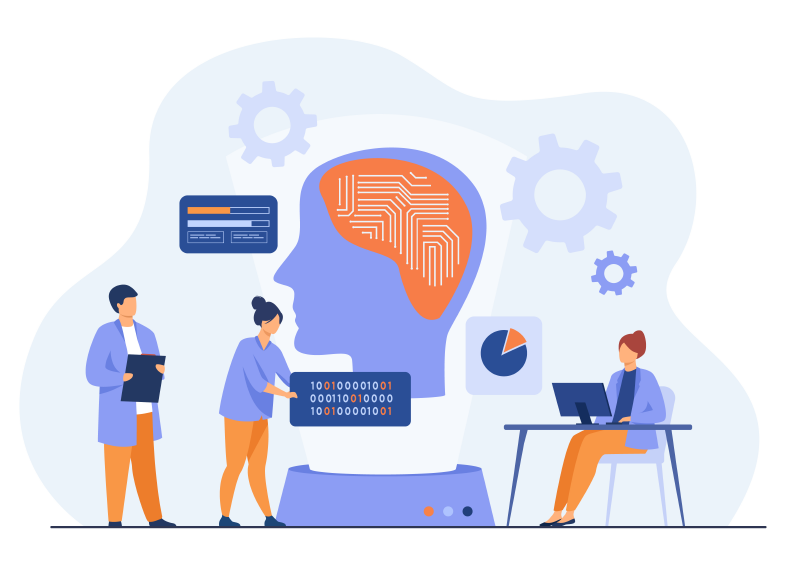- Home
- Blogs
Machine Learning in Digital Marketing: Predictive Analytics for Customer Behavior
Discover the power of machine learning in digital marketing with predictive analytics for understanding customer behavior.

Speed is the currency of modern technology—and, tangentially, business. The faster you can respond to changes in customer behavior, the better you will capitalize on opportunities.
As modern technology tools like machine learning algorithms become more sophisticated, businesses also gain better ways of interacting with customers and observing customer behavior.
Predictive analytics through machine learning is one of the foremost ways brands can capitalize on data from any digital marketing campaign. The more data gathered from customers about their spending patterns, shopping behavior, and overall preferences, the better a business can create a more personalized experience for customers.
Let’s examine customer behavior and how machine learning can improve your digital marketing strategy.
How Does Customer Behavior Affect Your Business?
Customer behavior influences your business in every way possible. Any organization should make it their business to constantly be updated with how their audience moves through and interacts with the world. Customers can change entire business trajectories through:
- Personal preference. All customers have preferences—personal tastes and buying patterns that heavily influence what and how they spend their money. Knowing what your audience wants and how they decide on what they want is crucial for a business to develop personalized offerings.
- Word of mouth. Despite what you may think, word of mouth is a present and incredibly influential aspect of customer behavior. Although marketing has primarily moved to the digital space, word-of-mouth marketing (i.e., from friends and family or influences) is a solid driving force for customer choice. Customers who are happy with your business are likelier to share it with others, while those who are unhappy will similarly want to share it with their circle.
- Market shifts. In the modern age of social media, microtrends come and go in the blink of an eye. Customer behavior can highly influence market shifts and trends and heavily impact your business.
- Price Sensitivity. Price is another significant factor customers consider when purchasing a product or service. Knowing if your customers are price-sensitive is crucial to setting appropriate pricing strategies.
Using Digital Marketing to Influence Customers
1 in 5 people with a smartphone spend more than 4.5 hours on their phone every single day. And the average person just spends a little over 3 hours! That’s plenty of opportunity for customer exposure to the latest trends and for your business to influence customer behavior.
There are several ways your business can utilize digital marketing techniques to reach through screens and capture your audience’s attention. Some of the foremost are:
Social Media Marketing
Roughly 61% of the global population has some form of social media. Depending on your target market, that percentage may be even higher, such as if you’re targeting Gen Zs or Millenials.
Indeed, social media marketing through apps like Instagram, Facebook, and TikTok is one of the most popular ways businesses cut through the online noise. On Tiktok, businesses “blow up” every day, seemingly by chance.
People spend hours every day on their phones, and those hours are your chance to put your product out there. You can market your product through traditional ads, like the ones that play in the middle of videos or in between social media posts, but there are also other avenues to consider.
On TikTok, the concept of live selling is slowly taking off. In some countries, businesses (regardless of scale) perform live demonstrations of their products during sales promotions or events.
Moreover, most businesses today have their own social media pages for customers to follow and stay updated on the brand’s latest.
Content Marketing
Content marketing is an umbrella term for using content to attract and retain a target audience. The success of content marketing hinges on brand trust and building credibility within your customer base.
Content marketing can come in various forms, including:
- Blog posts;
- Podcasts;
- Case Studies;
- Ebooks;
- Infographics;
- Videos;
- Articles;
And more. Businesses can publish content on their social media or websites to interact with and engage their audience.
Influencer Marketing
Influencer marketing is one of the most striking distinguishing factors of the 2020s. Large-scale influencers can make millions of dollars a year and can make any product go viral. Even small influencers (often called micro-influencers) have strong follower bases and can truly impact your business metrics.
As such, it is also one of the best ways to influence your customers and get them to buy your product. After all, who would you rather listen to—a random ad online or a real person vouching for the value of a product?
Stories sell, and influencer marketing is a good way to add a narrative to your product or service.
Search Engine Optimization
Search Engine Optimization or SEO is the process of optimizing your website for increased visibility on search engine platforms (most commonly Google). Digital marketing through SEO can look like this:
- Focusing on relevant keywords when generating content;
- Improving your website’s user experience;
- Creating high-quality content for your niche;
And much more!
The bottom line with Search Engine Optimization is to make sure that when potential customers are looking up sources in your field, your website is one of the first sites they click on.
Email Marketing
Despite what you may think, email marketing is not dead. Although focusing on social media is more conventional, email marketing still has many strong points.
You can use email marketing and targeted email campaigns to interact directly with your customer base. Email marketing is an excellent way to promote promotions and business updates, especially if you have a strong subscriber base.
Machine Learning and Predictive Analytics
Machine learning is an area of Artificial Intelligence that involves systems taking in large amounts of information to “learn” from them. In fact, machine learning is exactly what the name implies—it is the process of machine learning.
For instance, take a large data set of thousands of emails labeled either spam or not. Machine learning algorithms work by comparing what spam emails look like to legitimate ones.
The model will then extract patterns from the data set and use that information to predict whether an incoming email is spam or not. So, when an email comes into the system, it will be automatically filtered out if it’s spam.
But how can businesses leverage machine learning in operations?
Customer Segmentation
Customer segmentation is crucial when determining your target market and how to advertise your product or service. Knowing the types of people who engage and interact with your content is essential to creating a personalized customer experience.
You can use machine learning and predictive analytics to gather data insights on your digital footprint—website, socials, search engine hits, etc.- to determine which groups you need to target more.
For instance, if you find that most of the people who engage with your content are in the 15-25 age range, the best practice is to adjust your tone and style to fit the needs of that group.
Demand Forecasting
Demand forecasting is one of your business's best uses of predictive analytics. With proper demand forecasting, your business can:
- Retain appropriate inventory levels;
- Optimize production schedules and
- Improve resource allocation.
All of which help your business attain operational efficiency.
You can use machine learning to gather data from your website or third-party selling platforms to determine factors that influence your customers’ behavior patterns. These factors could include:
- Time of day;
- Day of the month;
- Gender;
- Age group; and
- Time spent on your website.
Knowing these things will not only help you improve operations but will also help you understand your business as a whole. You can obtain a fresh perspective on how your customers interact with your brand using predictive analytics.
To further enhance your understanding and capitalize on these insights, consider investing in adtech development. This will enable you to implement targeted advertising strategies based on predictive analytics, ensuring that your brand reaches the right audience at the right time, ultimately maximizing the impact of your marketing efforts.
Employee Retention
Employees are the backbone of any business. With the right team, a business can succeed. One of the best ways companies can ensure consistent, high-quality output is by hiring competent, top talent—ideally supplemented by high employee retention rates.
You can retain valuable talent through:
- Training programs;
- Above market benefits;
- Targeted initiatives; and
- Career progression incentives.
Although your employees aren’t your customers per se, they’re still an integral part of doing business. Knowing how to keep your employees satisfied is made more achievable through machine learning and the digital information age.
Supply Chain Optimization
In line with demand forecasting, predictive analytics and machine learning could also help optimize a supply chain. If a business knows when it will pick up, it will be able to adjust production volume and scale to match demand. On the flip side, if demand is low, production can be scaled down.
With machine learning and predictive analytics, you can analyze sales data to determine when production should be increased and when it should be toned down during the business year.
You can also correlate information from your digital platforms to alter supply chain information. For instance, if your social media platforms have a massive uptick in engagement, it might be an excellent choice to increase production while the interest is there.
Conclusion
Machine learning might sound too technical and intimidating, but it can boost your business through many tools that provide predictive analytics.
As intimidating as it may sound, you don’t have to learn about teaching an algorithm to process your data. However, knowing the fundamentals and how the process works is vital to understanding how it can contribute to your digital marketing efforts.

